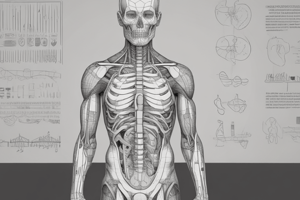Podcast
Questions and Answers
What type of joint permits uniaxial rotation?
What type of joint permits uniaxial rotation?
- Hinge joint
- Ball and socket joint
- Pivot joint (correct)
- Gliding joint
Which muscle is the major flexor of the elbow joint?
Which muscle is the major flexor of the elbow joint?
- Brachialis
- Triceps brachii
- Biceps brachii (correct)
- Brachioradialis
What is the insertion point of the triceps brachii muscle?
What is the insertion point of the triceps brachii muscle?
- Humerus
- Ulna (correct)
- Scapula
- Radius
What type of muscle decreases the angle between two bones?
What type of muscle decreases the angle between two bones?
Which muscle moves the limb away from the midline of the body?
Which muscle moves the limb away from the midline of the body?
What is the origin of the hamstrings muscles?
What is the origin of the hamstrings muscles?
Which muscle group is the antagonist to the quadriceps during knee flexion?
Which muscle group is the antagonist to the quadriceps during knee flexion?
What is the insertion point of the deltoid muscle?
What is the insertion point of the deltoid muscle?
What muscle is responsible for adduction at the shoulder joint?
What muscle is responsible for adduction at the shoulder joint?
Which muscle is named based on the shape of its muscle fibers?
Which muscle is named based on the shape of its muscle fibers?
What type of tissue is hyaline cartilage?
What type of tissue is hyaline cartilage?
Which cells build the bone matrix?
Which cells build the bone matrix?
What is the function of osteocytes?
What is the function of osteocytes?
What is the primary component of the bone matrix?
What is the primary component of the bone matrix?
Where is compact bone found?
Where is compact bone found?
What are osteons?
What are osteons?
What is the function of canaliculi in bone?
What is the function of canaliculi in bone?
Where are lacunae with osteocytes found?
Where are lacunae with osteocytes found?
What do perforating canals connect?
What do perforating canals connect?
What runs perpendicular to the long axis of the bone?
What runs perpendicular to the long axis of the bone?
Where is spongy bone primarily found?
Where is spongy bone primarily found?
What components make up a long bone?
What components make up a long bone?
What are the components of a skeletal muscle fiber?
What are the components of a skeletal muscle fiber?
How are joints functionally classified?
How are joints functionally classified?
What are the structural classifications of joints?
What are the structural classifications of joints?
What are the components of synovial joints?
What are the components of synovial joints?
What types of movements are associated with hinge joints?
What types of movements are associated with hinge joints?
What gives muscle cells their characteristic striation pattern?
What gives muscle cells their characteristic striation pattern?
What anchors skeletal muscles to bone or fascia?
What anchors skeletal muscles to bone or fascia?
What is the function of red or yellow marrow in the medullary cavity?
What is the function of red or yellow marrow in the medullary cavity?
Flashcards are hidden until you start studying
Study Notes
Anatomy and Physiology of Bones, Muscles, and Joints
- Spongy bone lacks osteons and is primarily found in the epiphyses of long bones, skull, ribs, and vertebrae, containing trabeculae and red bone marrow.
- Long bones consist of diaphysis (composed of compact bone), epiphyses (primarily spongy bone), epiphyseal plate for bone growth, and medullary cavity with red or yellow marrow.
- Components of long bones include the epiphyseal line, medullary cavity, periosteum, endosteum, and articular cartilage for joint surfaces.
- Skeletal muscles are composed of individual cells called fibers, bundled by endomysium, perimysium, and epimysium, with deep fascia, tendons, and aponeurosis anchoring them to bone or fascia.
- A skeletal muscle fiber has a sarcolemma, sarcoplasm with myofibrils and sarcoplasmic reticulum, and myofilaments consisting of actin, myosin, troponin, and tropomyosin.
- The arrangement of thick and thin myofilaments gives muscle cells their characteristic striation pattern, forming sarcomeres.
- Articulations and joints are functionally classified as synarthrotic (immovable), amphiarthrotic (slightly movable), or diarthrotic (freely movable) synovial joints.
- Structurally, joints are classified as fibrous (no joint cavity, bound by fibrous CT), cartilaginous (no joint cavity, connected by cartilage), or synovial (with a joint cavity held by an articular capsule and ligaments).
- Synovial joints have articular cartilage, a fibrous capsule, joint cavity with synovial fluid, and reinforcing ligaments for additional joint strength.
- Types of synovial joints include gliding (plane) joints for short gliding movements, hinge joints for flexion/extension, and pivot joints for rotation.
- Components of spongy bone include trabeculae and red bone marrow, primarily found in epiphyses of long bones and certain bones of the skull, ribs, and vertebrae.
- Long bones consist of diaphysis, epiphyses, epiphyseal plate, medullary cavity, periosteum, endosteum, and articular cartilage, providing structure and support for the body.
Studying That Suits You
Use AI to generate personalized quizzes and flashcards to suit your learning preferences.





